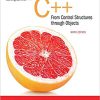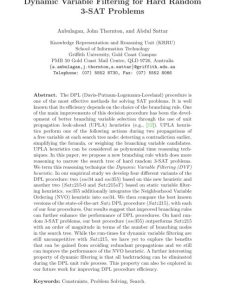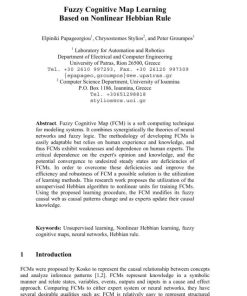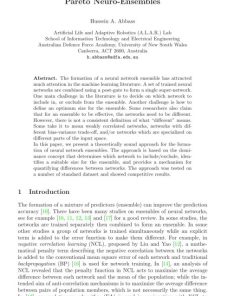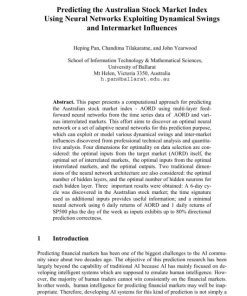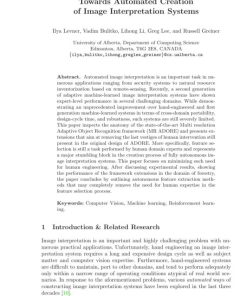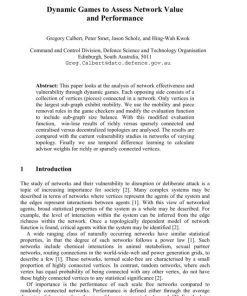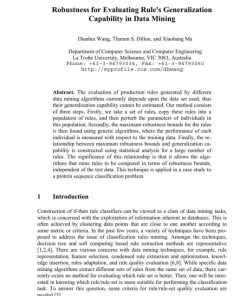LNAI 2903 Race Car Chassis Tuning Using Artificial Neural Networks 1st Edition by David Butler, Vishy Karri ISBN 9783540206460 354020646X
$50.00 Original price was: $50.00.$25.00Current price is: $25.00.
Authors:David Butler; Vishy Karri , Tags:AI 2003: Advances in Artificial Intelligence , Author sort:Butler, David & Karri, Vishy , Languages:Languages:eng , Published:Published:Nov 2003
LNAI 2903 Race Car Chassis Tuning Using Artificial Neural Networks 1st Edition by David Butler, Vishy Karri – Ebook PDF Instant Download/Delivery. 9783540206460 ,354020646X
Full download LNAI 2903 Race Car Chassis Tuning Using Artificial Neural Networks 1st Edition after payment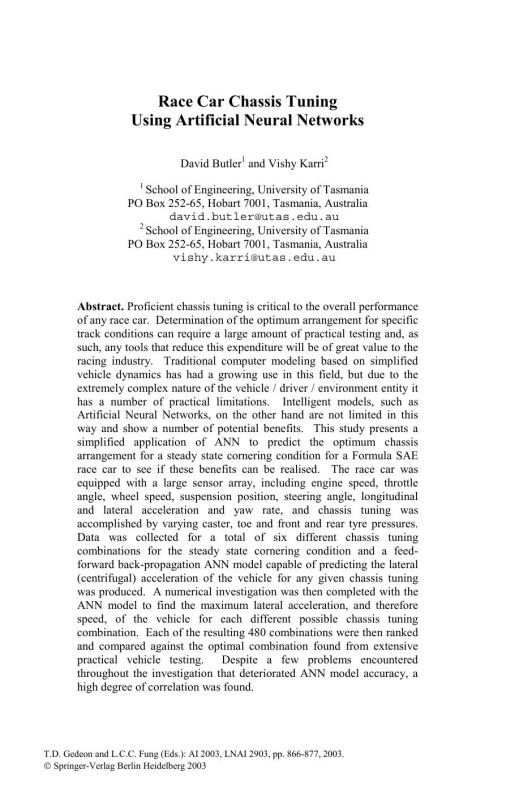
Product details:
ISBN 10: 354020646X
ISBN 13: 9783540206460
Author: David Butler, Vishy Karri
Proficient chassis tuning is critical to the overall performance of any race car. Determination of the optimum arrangement for specific track conditions can require a large amount of practical testing and, as such, any tools that reduce this expenditure will be of great value to the racing industry. Traditional computer modeling based on simplified vehicle dynamics has had a growing use in this field, but due to the extremely complex nature of the vehicle / driver / environment entity it has a number of practical limitations. Intelligent models, such as Artificial Neural Networks, on the other hand are not limited in this way and show a number of potential benefits. This study presents a simplified application of ANN to predict the optimum chassis arrangement for a steady state cornering condition for a Formula SAE race car to see if these benefits can be realised. The race car was equipped with a large sensor array, including engine speed, throttle angle, wheel speed, suspension position, steering angle, longitudinal and lateral acceleration and yaw rate, and chassis tuning was accomplished by varying caster, toe and front and rear tyre pressures. Data was collected for a total of six different chassis tuning combinations for the steady state cornering condition and a feed-forward back-propagation ANN model capable of predicting the lateral (centrifugal) acceleration of the vehicle for any given chassis tuning was produced. A numerical investigation was then completed with the ANN model to find the maximum lateral acceleration, and therefore speed, of the vehicle for each different possible chassis tuning combination. Each of the resulting 480 combinations were then ranked and compared against the optimal combination found from extensive practical vehicle testing. Despite a few problems encountered throughout the investigation that deteriorated ANN model accuracy, a high degree of correlation was found.
LNAI 2903 Race Car Chassis Tuning Using Artificial Neural Networks 1st Edition Table of contents:
Chapter 1: Introduction to Race Car Chassis Tuning
- 1.1. Importance of Chassis in Race Car Performance
- 1.2. Overview of the Components Involved in Chassis Tuning
- 1.3. The Challenges of Traditional Chassis Tuning Methods
- 1.4. Integrating Machine Learning into Automotive Engineering
- 1.5. Objectives of the Book and Applications of ANNs in Chassis Tuning
Chapter 2: Basics of Artificial Neural Networks (ANNs)
- 2.1. Introduction to Neural Networks and Their Components
- 2.2. Types of Neural Networks: Feedforward, Convolutional, and Recurrent
- 2.3. The Training Process: Backpropagation and Gradient Descent
- 2.4. Activation Functions, Regularization, and Optimization Techniques
- 2.5. ANN Architectures in Engineering and Automotive Applications
Chapter 3: Understanding Race Car Chassis Design and Performance
- 3.1. Key Factors Affecting Chassis Performance: Weight Distribution, Suspension, Aerodynamics
- 3.2. Suspension Geometry and Its Impact on Handling
- 3.3. The Role of Tire Grip and Road Conditions
- 3.4. Dynamic Behavior of a Race Car: Forces and Moments
- 3.5. Quantifying Performance Metrics: Lap Times, Cornering Speed, and Stability
Chapter 4: Data Collection and Feature Engineering for Chassis Tuning
- 4.1. Identifying Relevant Data Sources: Sensors, Telemetry, and Simulations
- 4.2. Key Features for Chassis Performance Prediction
- 4.3. Data Preprocessing: Normalization, Scaling, and Cleaning
- 4.4. Feature Selection and Dimensionality Reduction
- 4.5. Challenges in Real-World Data Collection for Race Car Tuning
Chapter 5: Building Neural Network Models for Chassis Tuning
- 5.1. Choosing the Right ANN Architecture for Chassis Optimization
- 5.2. Input Variables: Handling Complex, Multi-Dimensional Data
- 5.3. Output Variables: Performance Metrics and Design Parameters
- 5.4. Model Training: Supervised vs. Reinforcement Learning for Tuning
- 5.5. Model Validation and Testing: Cross-Validation and Overfitting Prevention
Chapter 6: Optimizing Chassis Tuning Using ANNs
- 6.1. Defining the Objective Function for Chassis Optimization
- 6.2. Multi-Objective Optimization in Chassis Tuning
- 6.3. Training Neural Networks for Multi-Objective Optimization Tasks
- 6.4. Hyperparameter Tuning and Neural Network Fine-Tuning
- 6.5. Case Studies of ANN-Based Chassis Optimization in Racing
Chapter 7: Advanced Machine Learning Techniques in Chassis Tuning
- 7.1. Deep Learning Models for Complex Chassis Design
- 7.2. Reinforcement Learning for Dynamic Tuning in Race Conditions
- 7.3. Evolutionary Algorithms and Genetic Programming for Chassis Optimization
- 7.4. Transfer Learning and Domain Adaptation in Race Car Design
- 7.5. Hybrid Models: Combining ANNs with Traditional Engineering Techniques
Chapter 8: Practical Applications and Case Studies
- 8.1. Case Study 1: ANN-Based Optimization of Suspension Tuning
- 8.2. Case Study 2: Improving Aerodynamic Efficiency with Neural Networks
- 8.3. Case Study 3: Predicting Lap Times Based on Chassis Parameters
- 8.4. Real-World Application: Race Car Testing and Simulations
- 8.5. Lessons Learned from Industry Deployments and Challenges
Chapter 9: Integration with Simulation and Real-Time Systems
- 9.1. Using Simulations for Chassis Tuning: Virtual vs. Real-World Performance
- 9.2. Real-Time Data Acquisition and Feedback for Dynamic Adjustments
- 9.3. Integrating Neural Networks with Vehicle Dynamics Simulators
- 9.4. On-Track Testing: From Simulation to Real-World Validation
- 9.5. Closed-Loop Optimization Systems in Race Car Engineering
Chapter 10: Future Directions in Race Car Chassis Tuning with AI
- 10.1. Emerging Trends in AI and Machine Learning for Automotive Engineering
- 10.2. Autonomous and Semi-Autonomous Racing Cars
- 10.3. The Role of AI in Sustainable and Energy-Efficient Racing
- 10.4. The Future of AI-Driven Design and Manufacturing in Motorsports
- 10.5. Ethical Considerations and Challenges in AI for Race Car Engineering
Chapter 11: Conclusion
- 11.1. Summary of Key Insights
- 11.2. The Role of Artificial Neural Networks in Advancing Automotive Engineering
- 11.3. The Future of Machine Learning in High-Performance Vehicle Design
- 11.4. Final Thoughts on Race Car Chassis Tuning and AI Integration
People also search for LNAI 2903 Race Car Chassis Tuning Using Artificial Neural Networks 1st Edition:
race car chassis design and construction pdf
race car chassis fabrication near me
race car chassis builders near me
race car chassis fabrication
You may also like…
eBook PDF
LNAI 2903 Pareto Neuro Ensembles 1st Edition by Hussein Abbass ISBN 9783540206460 354020646X

